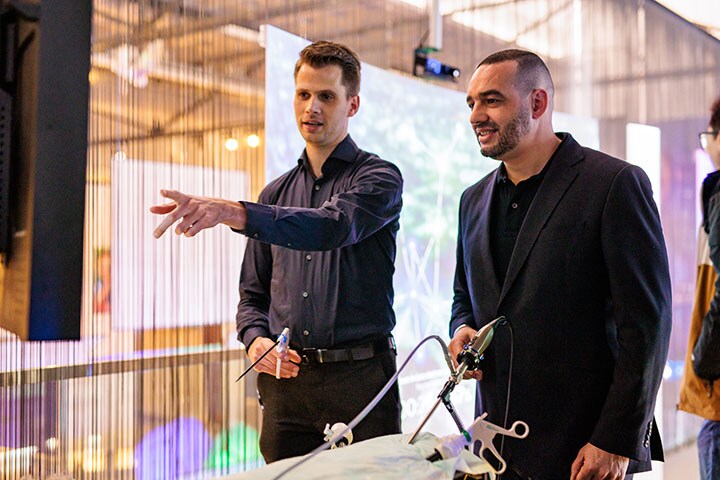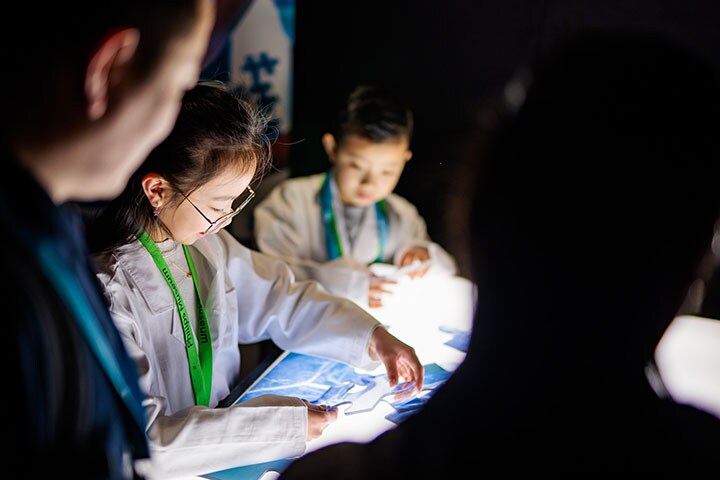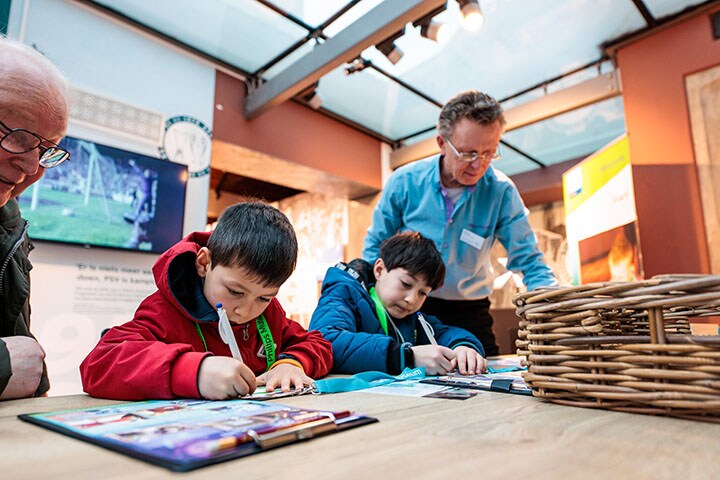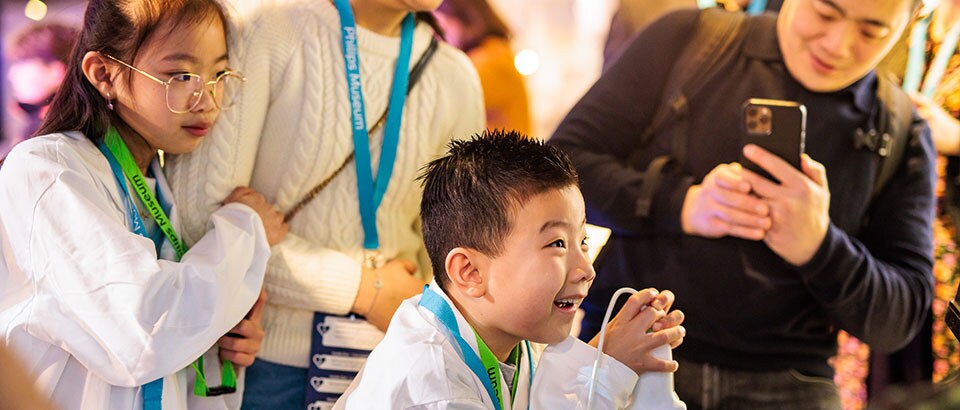Ervaren wat bewegen doet met je hartslag, zelf een echo-apparaat bedienen en leren hoe kunstmatige intelligentie dokters kan ondersteunen. De bezoekers van HealthLab in het Philips Museum werden op een interactieve reis genomen door de vele mogelijkheden binnen de gezondheidszorg. De toekomstige techneuten, artsen en radiologen kregen zo inzicht in de rol van technologie in gezondheid.
Het Philips Museum stond tijdens HealthLab in het weekend van 11 en 12 februari in het teken van gezondheid. HealthLab is een jaarlijks terugkerend gezondheidsevenement waar diverse Philips-afdelingen, de Hartstichting, Fontys Hogeschool en WildWoozt bezoekers inspireren en informeren. Het museum stond vol met speciale stands waarbij bezoekers meten en ervaren hoe innovaties in gezondheidszorg helpen gezonder te leven.
Gezonder en gelukkiger leven
Wethouder Samir Toub van de gemeente Eindhoven was een van de eerste bezoekers van het evenement. Hij kreeg een rondleiding door het Philips Museum, langs de vele stands. “Met het initiatief HealthLab wordt er in onze regio weer een stap gezet naar een gezonder leven. In Eindhoven zetten we ons in voor een eerlijke kans op een gezonder en gelukkiger leven voor iedereen. HealthLab sluit hier naadloos op aan”, zei hij tijdens aan het evenement.

Brede kijk
De diversiteit aan stands zorgde voor een brede kijk aan mogelijkheden van technologie binnen de gezondheidszorg. De families met kinderen, reguliere bezoekers, expats en andere geïnteresseerden lieten zich graag informeren door de enthousiaste presentatoren. Bijna duizend geïnteresseerden trokken naar het Philips Museum tijdens deze zevende editie van HealthLab.
Indrukwekkende eerste keer
“Kinderen vonden de operatie-simulator die we van het Catharina Ziekenhuis mochten lenen erg leuk en trok veel aandacht”, zegt Luc Geurts, Senior Design Strategist. “Bezoekers vonden het indrukwekkend te ontdekken welke organen en anatomische structuren ze zien in CT-beelden. Dat hebben veel mensen nog nooit gezien. Het 3D-holografisch scherm was echt een eyeopener voor velen en maakte veel indruk.”

Toegevoegde waarde
Luc stond samen met zijn collega’s Jon Pluyter, Igor Jacobs en Ewout Buhler bij de stand die ging over Human-Centered Artificial Intelligence (AI) en Alvleesklierkanker. “Onze AI-opstelling helpt echt om het abstract lijkende concept uit te leggen en te vertellen wat de toegevoegde waarde is van kunstmatige intelligentie”, zegt Ewout, Customer Project Manager. “Sommige mensen denken dat AI de dokter vervangt, het is goed uit te leggen dat dat net niet aan de hand is, dat AI er is om de dokter te ondersteunen. AI stelt de medisch professionals in staat sneller en beter geïnformeerde diagnoses en behandelingen te kiezen.”
Succesformule
De combinatie van uitleggen met een echt apparaat bleek bij meerdere stands een succesformule. “Normaal gesproken ga ik naar ziekenhuizen om uitleg te geven over echosystemen, nu mocht ik het uitleggen aan kinderen en ander bezoekers”, zegt Kevin Koeken. De bezoekers mochten met een aantal draagbare echo-apparaten (Lumify) zelf een scan maken om te zien of ze onderscheid konden maken tussen komkommers, tomaten, Lego en druiven. “Veel mensen kennen echografie, maar hebben geen idee hoe het werkt. Dit was een leuke manier om te kunnen demonsteren.”
Voor alle leeftijden
Cor van den Boogaard stond bij de stand met de MR- en Röntgen-puzzel. Het was zijn vierde editie van HealthLab en vond ook deze keer weer geslaagd. “Vooral het enthousiasme van de bezoekers valt op”, zegt hij. “Iedereen doet met volle overtuiging mee aan de diverse activiteiten. En je krijgt leuke feedback terug. Ze vinden het leuk en leren er veel van. Dat maakt het evenement interessant voor alle leeftijden.”

Educatie en inspiratie
De ambitie is om volgend jaar het gezondheidsevenement grootser aan te pakken. Een denkrichting is om scholen erbij te betrekken. “Gezondheid en het menselijk lichaam zijn in het onderwijs ook belangrijke onderwerpen”, zegt Olga Coolen, directeur Philips Museum. “Onze combinatie van educatie en inspiratie werkt ook zeker op scholen. Voor de volgende editie bekijken we daarom hoe we het evenement ook geschikt en toegankelijk kunnen maken voor scholieren.”

Healthlab: a source of inspiration for current and future generations
Exploring how exercise influences your heartbeat, operating an ultrasound machine and learn how artificial intelligence can support doctors. Visitors to HealthLab at the Philips Museum were taken on an interactive journey through the many possibilities within healthcare. The future techies, doctors and radiologists gained insight into the role of technology in health.
The Philips Museum was all about Health during HealthLab on February 11 and 12. The annual health event is organized by various Philips departments, the Heart Foundation, Fontys University of Applied Sciences and WildWoozt to inspire and inform visitors. The museum was filled with booths where visitors could measure and experience how innovations in healthcare can help live a healthier life.
Healthier and happier life
Counciler Samir Toub of the Municipality of Eindhoven was one of the first visitors of the event. "With the HealthLab initiative, we are taking another step towards a healthier life in our region. In Eindhoven, we are committed to giving everyone a fair chance at a healthier and happier life. HealthLab fits this purpose seamlessly," he said during to the event.

Broad perspective
The various booths provided a broad perspective of technology within healthcare. By listening to the enthusiastic presenters, families with children, regular visitors, expats and other interested parties learned more about the possibilities of technology within healthcare. Almost a thousand visitors visted to the Philips Museum during this seventh edition of HealthLab.
Impressive first time
"The surgery simulator we borrowed from the Catharina Hospital was really popular by children and attracted a lot of attention," said Luc Geurts, Senior Design Strategist. "Visitors were impressed to see what organs and anatomical structures they see in CT images. Many people have never seen that before. The 3D holographic screen was really an eye opener for many and made a big impression."

Added value
Luc stood with his colleagues Jon Pluyter, Igor Jacobs and Ewout Buhler at the booth that was about Human-Centered Artificial Intelligence (AI) and Pancreatic Cancer. "Our AI setup really helps to explain what the added value of artificial intelligence is," said Ewout, Customer Project Manager. "Some people think AI replaces the doctor, which is not the case, as AI is there to support the doctor. AI enables medical professionals to make faster and more informed diagnoses and treatments.”
Success Formula
Exhibiting a real device proved to be a success formula at several booths. "Normally I go to hospitals to explain ultrasound systems, now I got to explain it to children and other visitors," says Kevin Koeken. Using a portable ultrasound machines (Lumify) visitors could make their own scan to distinguish cucumbers, tomatoes, Lego and grapes. "Many people know ultrasound but have no idea how it works. This was a fun way to demonstrate this."
An event for all ages
Cor van den Boogaard was at the booth with the MR and X-ray puzzle. It was his fourth edition of HealthLab and thought it was another successful edition. "What strikes me is the enthusiasm of the visitors," he says. "Everyone participates enthusiastically in the various activities. And you get nice feedback. They like it and learn a lot from it. That makes the event interesting for all ages."
Education and inspiration
The ambition is to expand the health event next year, for example by involving schools. "Health and the human body are also important topics in education," says Olga Coolen, Director of the Philips Museum. "Our combination of education and inspiration certainly works in schools as well. For the next edition, we are looking at how we can also make the event suitable and accessible for children at schools."
